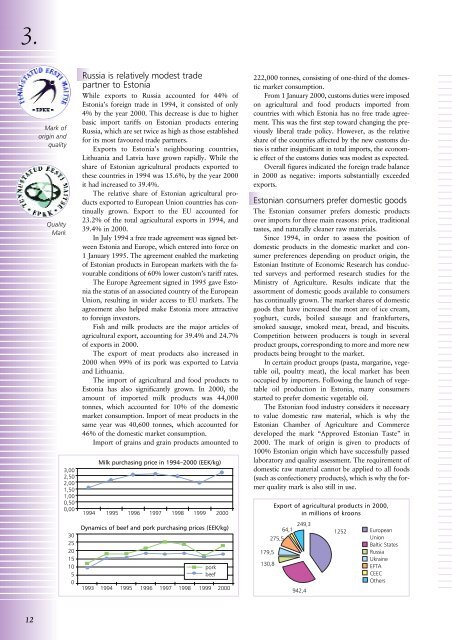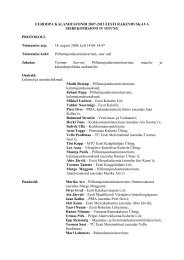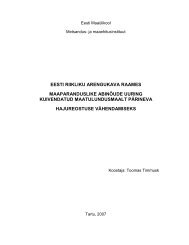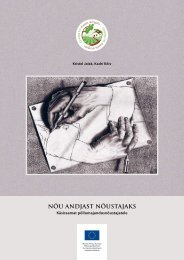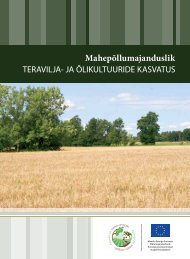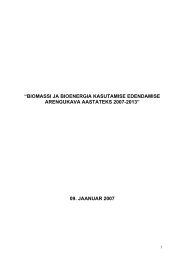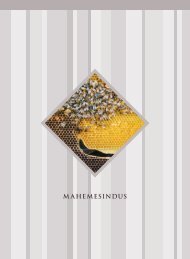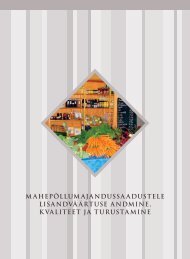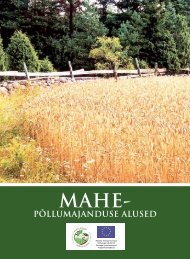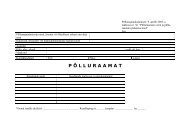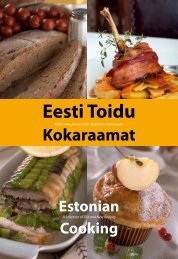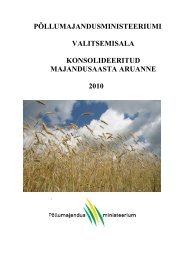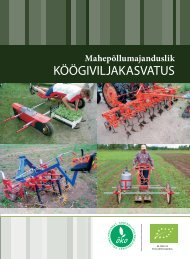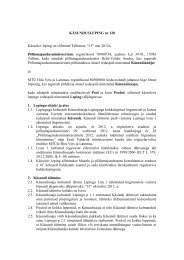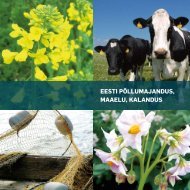estonian agriculture, rural economy and food industry
estonian agriculture, rural economy and food industry
estonian agriculture, rural economy and food industry
Create successful ePaper yourself
Turn your PDF publications into a flip-book with our unique Google optimized e-Paper software.
3.<br />
Mark of<br />
origin <strong>and</strong><br />
quality<br />
Quality<br />
Mark<br />
3,00<br />
2,50<br />
2,00<br />
1,50<br />
1,00<br />
0,50<br />
0,00<br />
30<br />
25<br />
20<br />
15<br />
10<br />
5<br />
0<br />
Russia is relatively modest trade<br />
partner to Estonia<br />
While exports to Russia accounted for 44% of<br />
Estonia’s foreign trade in 1994, it consisted of only<br />
4% by the year 2000. This decrease is due to higher<br />
basic import tariffs on Estonian products entering<br />
Russia, which are set twice as high as those established<br />
for its most favoured trade partners.<br />
Exports to Estonia’s neighbouring countries,<br />
Lithuania <strong>and</strong> Latvia have grown rapidly. While the<br />
share of Estonian agricultural products exported to<br />
these countries in 1994 was 15.6%, by the year 2000<br />
it had increased to 39.4%.<br />
The relative share of Estonian agricultural products<br />
exported to European Union countries has continually<br />
grown. Export to the EU accounted for<br />
23.2% of the total agricultural exports in 1994, <strong>and</strong><br />
39.4% in 2000.<br />
In July 1994 a free trade agreement was signed between<br />
Estonia <strong>and</strong> Europe, which entered into force on<br />
1 January 1995. The agreement enabled the marketing<br />
of Estonian products in European markets with the favourable<br />
conditions of 60% lower custom’s tariff rates.<br />
The Europe Agreement signed in 1995 gave Estonia<br />
the status of an associated country of the European<br />
Union, resulting in wider access to EU markets. The<br />
agreement also helped make Estonia more attractive<br />
to foreign investors.<br />
Fish <strong>and</strong> milk products are the major articles of<br />
agricultural export, accounting for 39.4% <strong>and</strong> 24.7%<br />
of exports in 2000.<br />
The export of meat products also increased in<br />
2000 when 99% of its pork was exported to Latvia<br />
<strong>and</strong> Lithuania.<br />
The import of agricultural <strong>and</strong> <strong>food</strong> products to<br />
Estonia has also significantly grown. In 2000, the<br />
amount of imported milk products was 44,000<br />
tonnes, which accounted for 10% of the domestic<br />
market consumption. Import of meat products in the<br />
same year was 40,600 tonnes, which accounted for<br />
46% of the domestic market consumption.<br />
Import of grains <strong>and</strong> grain products amounted to<br />
Milk purchasing price in 1994–2000 (EEK/kg)<br />
1994 1995 1996 1997 1998 1999 2000<br />
Dynamics of beef <strong>and</strong> pork purchasing prices (EEK/kg)<br />
pork<br />
beef<br />
1993 1994 1995 1996 1997 1998 1999 2000<br />
222,000 tonnes, consisting of one-third of the domestic<br />
market consumption.<br />
From 1 January 2000, customs duties were imposed<br />
on agricultural <strong>and</strong> <strong>food</strong> products imported from<br />
countries with which Estonia has no free trade agreement.<br />
This was the first step toward changing the previously<br />
liberal trade policy. However, as the relative<br />
share of the countries affected by the new customs duties<br />
is rather insignificant in total imports, the economic<br />
effect of the customs duties was modest as expected.<br />
Overall figures indicated the foreign trade balance<br />
in 2000 as negative: imports substantially exceeded<br />
exports.<br />
Estonian consumers prefer domestic goods<br />
The Estonian consumer prefers domestic products<br />
over imports for three main reasons: price, traditional<br />
tastes, <strong>and</strong> naturally cleaner raw materials.<br />
Since 1994, in order to assess the position of<br />
domestic products in the domestic market <strong>and</strong> consumer<br />
preferences depending on product origin, the<br />
Estonian Institute of Economic Research has conducted<br />
surveys <strong>and</strong> performed research studies for the<br />
Ministry of Agriculture. Results indicate that the<br />
assortment of domestic goods available to consumers<br />
has continually grown. The market shares of domestic<br />
goods that have increased the most are of ice cream,<br />
yoghurt, curds, boiled sausage <strong>and</strong> frankfurters,<br />
smoked sausage, smoked meat, bread, <strong>and</strong> biscuits.<br />
Competition between producers is tough in several<br />
product groups, corresponding to more <strong>and</strong> more new<br />
products being brought to the market.<br />
In certain product groups (pasta, margarine, vegetable<br />
oil, poultry meat), the local market has been<br />
occupied by importers. Following the launch of vegetable<br />
oil production in Estonia, many consumers<br />
started to prefer domestic vegetable oil.<br />
The Estonian <strong>food</strong> <strong>industry</strong> considers it necessary<br />
to value domestic raw material, which is why the<br />
Estonian Chamber of Agriculture <strong>and</strong> Commerce<br />
developed the mark “Approved Estonian Taste” in<br />
2000. The mark of origin is given to products of<br />
100% Estonian origin which have successfully passed<br />
laboratory <strong>and</strong> quality assessment. The requirement of<br />
domestic raw material cannot be applied to all <strong>food</strong>s<br />
(such as confectionery products), which is why the former<br />
quality mark is also still in use.<br />
179,5<br />
130,8<br />
Export of agricultural products in 2000,<br />
in millions of kroons<br />
64,1<br />
275,5<br />
249,3<br />
942,4<br />
1252<br />
European<br />
Union<br />
Baltic States<br />
Russia<br />
Ukraine<br />
EFTA<br />
CEEC<br />
Others<br />
12


